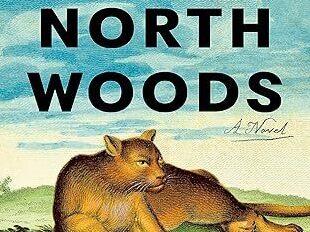Section Branding
Header Content
'North Woods' is the story of a place and its inhabitants over centuries
Primary Content
Location, location, location. Daniel Mason's gorgeous fifth novel, North Woods, is the story of a place — a yellow house deep in the woods of western Massachusetts — and its motley succession of occupants, human and otherwise, who leave their mark on the property over the course of four centuries.
It all starts with a pair of young lovers who, "casting off their Puritan yokes...absconded to...their private Arcadia," Mason writes. "They had come to the spot in the freshness of June, chased from the village by its people, threading deer path through the forest, the valleys, the fern groves, and the quaking bogs...Gone was England, gone the Colony."
We read about what became of the woman decades later in the anonymous letter of a "nightmaid," who reported that the "heathens" came "in great number," setting fire to the stockades and slaying her family and neighbors. Captured with her baby, the nightmaid writes about how she was taken to a log and stone house beneath a mountain and nursed back to health by an old woman with an iron crucifix around her neck and a cherished Bible — part of the pair of young lovers — who was a friend of the Indian who spared the nightmaid. When avenging British soldiers turn up, the old woman does what she can to protect her friends.
North Woods manages, impressively, to balance both the narrow and the long view, intimately focusing on the lives of each of the house's inhabitants, yet expansively encompassing American history, natural history, and the relentless march of time and the cycle of the seasons.
The novel is above all a tale of ephemerality and succession, of the way time accrues in layers, like sedimentary soil. Many of Mason's characters and creatures come to violent ends. They die by axe, by gunshot, by exposure, by heart attack and heartache, by car accident, by mountain lions known as catamounts. The forest, too, suffers, savagely cleared for grazing, lashed by winds, incinerated by wildfires. Beloved ash trees, beeches, chestnuts, elms, and hemlocks are blighted by various invasive fungi, insects, and other pathogens. The present is haunted by the past, both literally and figuratively.
A post-doctoral fellow studying "spring ephemerals — deep woodland flowers that bloomed briefly in the fleeting sunlight before the trees leafed out and the canopy closed" — is a late addition to Mason's extensive cast. She neatly sums up the novel's overarching theme: "The only way to understand the world as something other than a tale of loss is to see it as a tale of change."
One of the delights of North Woods is the sheer variety of Mason's characters. These include an apple-obsessed orchardist who fights on the wrong side of the Revolutionary War, and his twin daughters, one fierce, the other lovelorn; a lonely, closeted, naturalist painter who all too briefly connects with his ideal soulmate; a young black mother fleeing slavery and bounty hunters; a conjuror; a schizophrenic whose mother corresponds with prison inmates while her son hallucinates about the house's former inhabitants; a reporter for True Crime magazine; a recently widowed history buff barred from his historical society for sexual misbehavior.
But it is the elegance with which Mason spins and links these stories in 12 chapters (each roughly connected to a different month) that truly dazzles. In later sections, he circles back decades to tie up loose ends, or to posthumously pair characters whose time on Earth is separated by centuries. One example: at a retrospective exhibit of the lonely 19th century artist's work, the post-doctoral student — who knows nothing of the artist's long residence in the yellow house — is entranced by the intricate detail with which he painted healthy trees she has known only in their blighted state.
Mason enhances the sense of ongoing change through lush descriptions of the natural environment and ghostly presences that at various points channel Nathaniel Hawthorne, Henry David Thoreau, Richard Powers' The Overstory, and George Saunders' Lincoln in the Bardo. There are "logs, fungus-feathered like turkey," he writes, and March dankness, with "the bare trees, the mists, the mud like folded slabs of potter's clay."
Mason's medical and psychiatric training inform a case history of a mid-20th century mentally ill patient facing a possible lobotomy, as well as descriptions of decaying corpses — which recall Jim Crace's sensual account of the physical aftermath of the murder of a pair of zoologists in Being Dead (2001).
But even death can be regenerative, as demonstrated in this astonishing passage about the germination of a special apple variety that emerges from the shallow grave of a British soldier:
"Now, in the place that was once the belly of the man who offered the apple to the woman, one of the apple seeds, sheltered in the shattered rib cage, breaks its coat and drops a root into the soil, lifts a pair of pale green cotyledons. A shoot rises, thickens, seeks the bars of light above it, gently parts the fifth and sixth ribs that once guarded the dead man's meager heart."
Note the word meager. It's a descriptive that — gently, quietly — separates a great writer from a merely good one. There is nothing meager about this book, or Daniel Mason's talent.
Copyright 2023 NPR. To see more, visit https://www.npr.org.

